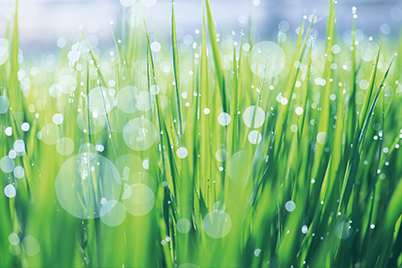The morning after a humid afternoon or after a night of rain. The dewdrops that remain on plants and flowers are a poetic sight that, when captured as circles of bokeh, transform the scene into a magical fantasy world. Here’s how to achieve the effect. (Reported by: Haruhi, Digital Camera Magazine)

EOS 5D Mark IV/ EF100mm f/2.8L Macro IS USM/ Aperture-priority AE (f/3.5, 1/1000 sec, EV +1.0)/ ISO 200/ WB: Auto
Recap: How bokeh circles are created
Bokeh circles are formed when you use a larger aperture (small f-number) to capture tiny dots of light (point light sources) so that they are out of focus. When sunlight falls directly on dew and water droplets, it makes them shiny and transforms them into point light sources, too.
Other possible point light sources:
- Light shining from between leaves and tree branches
- Sunlight reflecting off water surfaces
- Light bulbs and decorative lights
Tip: It is easier to control the bokeh intensity (size of the bokeh circle) when you use a telephoto lens. For the main image, I used a 100mm macro lens: the EF100mm f/2.8L Macro IS USM.
Also see:
4 Easy Steps to Capture Those Elusive Bokeh Circles!
Where Should I Focus On to Capture Beautiful Bokeh Circles?
Step 1: Shoot early in the morning before sunrise
There is usually more dew on cool mornings that come after a humid afternoon. If not, look out for the water droplets that remain on grass and flowers the morning after a night of rain. They start to evaporate once the sun is out, so shoot as early as possible. I took the main shot at around 6am, before sunrise.

Go too late and there won’t be any dew to create bokeh circles with!
Step 2: Use a long focal length and an f-number close to the maximum aperture
Look for an angle where the dew sparkles. The larger the aperture, the bigger the bokeh circles. However, maximum aperture is not necessarily best: you usually get a clearer, circular shape when you stop down just a bit from maximum aperture. Here, I used a 100mm macro lens at f/3.5, slightly narrower than its f/2.8 maximum aperture. Using a telephoto focal length also results in larger bokeh circles compared to if you use a wide angle or standard focal length.
f/5.6

Using a narrow aperture setting results in small bokeh circles.
Step 3: Make the shot look shinier—use positive exposure compensation
I originally took the shot without exposure compensation (see the first shot below). The bokeh circles were bright because I shot in backlight, but I felt that the leaves were slightly too dull. I wanted my shot to express the cheerful feel of a refreshing morning--the start of a brand new day—so I made the entire image brighter by adjusting exposure compensation up by one stop to EV +1.0.
EV ±0

EV +1.0

How else can you photograph dew and water droplets? Check out these articles for more ideas and step by step tutorials:
Macrophotography: Creating An Elegant Ombre Background with f/2.8 Lens
How to Photograph Water Droplets that Sparkle!
Built-in Flash Techniques #6: Magical Bokeh Circles on a Rainy Day
Flowers in Water Droplets
Macro Lens Techniques: Brilliantly Capture the Sparkle in a Water Droplet
Whether it's soft, smooth bokeh or unique bubble bokeh, the RF100mm f/2.8L Macro IS USM has a Spherical Aberration control ring that lets you adjust how your bokeh looks! Find out more here:
RF100mm f/2.8L Macro IS USM: 1.4x Macro with Adjustable Bokeh Flavour
Receive the latest update on photography news, tips and tricks.
Be part of the SNAPSHOT Community.
Sign Up Now!About the Author
A monthly magazine that believes that enjoyment of photography will increase the more one learns about camera functions. It delivers news on the latest cameras and features and regularly introduces various photography techniques.
Published by Impress Corporation
The common thread that binds landscape photographer Haruhi’s images is the theme of “healing”. To him, each magnificent scene he meets is unique and unrepeatable, hence, he approaches them with a heart that is full of gratitude and yet “unencumbered and formless like the wind”. Recent published works include a photo collection, Iyashi no Shizuku [Drops of Healing] (Fukei Shashin Shuppan)
Twitter:@mu_haruhi



































